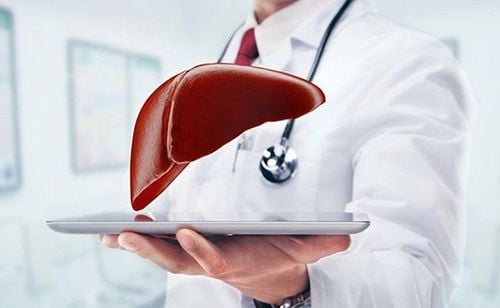This is an automatically translated article.
The article was professionally consulted by Doctor Department of Gastroenterology - Endoscopy, Department of Medical Examination & Internal Medicine - Vinmec Central Park International General Hospital.
Hepatitis D is caused by the hepatitis D virus, which can lead to many complications such as liver scarring, cirrhosis and liver cancer. So who is susceptible to hepatitis D virus?
1. What is the hepatitis D virus?
Hepatitis D is a liver disease caused by the hepatitis D virus (HDV). HDV is one of many forms of hepatitis. This is an infection that causes the liver to become inflamed. This inflammation can impair liver function and cause long-term liver problems such as liver scarring and cancer. HDV is known as a satellite virus, as it can only infect people who are also infected with the hepatitis B virus (HBV).
Hepatitis D can be acute or chronic. Acute hepatitis D comes on suddenly and often causes more severe symptoms. If the infection lasts six months or longer, it becomes chronic hepatitis D. The virus can be present in the body for several months before symptoms occur. When chronic hepatitis D progresses, it will lead to many dangerous complications such as liver scarring, cirrhosis.
Currently, there is no cure for hepatitis D, but it is preventable in people infected with hepatitis B. Early treatment can also help prevent liver failure.
Hepatitis D can be acquired concurrently with hepatitis B as a co-infection or as a superinfection in people who are already chronically infected with hepatitis B.
Hepatitis D is common in Eastern Europe, Southern Europe, the Mediterranean region, the Middle East, West and Central Africa, East Asia, and the Amazon basin in South America.
There are 8 different HDV liver types that can be found globally. They all share the same transmission line and risk group. Genotype HDV 1 circulates mainly in North America, Europe, the Middle East, and North Africa. HDV genotypes 2 and 4 can be found in East Asia; genotype 3 is found only in the Amazon basin in South America and genotypes 5, 6, 7, and 8 are found in West and Central Africa.
Hepatitis D virus is transmitted mainly through skin-related activities and to a lesser extent through mucosal contact with blood or body fluids (semen and saliva) such as: unprotected sex healthy, sharing needles, toothbrushes, contact with blood or open wounds of an infected person.

2. Who is susceptible to hepatitis D virus?
Persons susceptible to hepatitis D include:
People with chronic hepatitis B infection Infants of mothers infected with HDV Unhealthy sex with partners infected with hepatitis D. Same-sex relationships Injectors drugs Household contact of people infected with HDV Healthcare workers are at risk of exposure through contact with infected blood or body fluids. Patients on hemodialysis.

3. Signs and symptoms of hepatitis D virus
The symptoms of hepatitis B and hepatitis D are similar, so it can be difficult to determine which disease is causing the symptoms. In some cases, hepatitis D can make hepatitis B symptoms worse. It can also cause symptoms in people with hepatitis B. Some common symptoms common in people with hepatitis D include:
Fever Fatigue Loss of appetite Nausea and vomiting Abdominal pain Dark urine Colored bowel movements Joint pain Jaundice These signs and symptoms usually appear 3 weeks to 7 weeks after the initial infection. People who are coinfected with HBV/HDV have different symptoms than those with HDV superinfection. Acute hepatitis occurs in people with HBV/HDV infection. Thus, their symptoms may follow a two-phase course. Symptoms of HBV/HDV coinfection can range from mild to severe (fulminant hepatitis), but for most people, coinfection is self-limiting: less than 5% of people with the infection go on to have a chronic infection. chronic.

4. Diagnosis and treatment of hepatitis D virus
Diagnosis
To accurately diagnose the condition, the doctor will perform a blood test to detect antibodies against hepatitis D in the blood. If antibodies are found, the patient has been exposed to the virus.
Your doctor will also check your liver function if they suspect liver damage.
Treatment

There is currently no specific treatment for acute or chronic hepatitis D. Unlike other forms of hepatitis, current antiviral drugs appear to be very effective in treating HDV.
Patients may be prescribed interferon for up to 12 months. Interferon is a protein that can stop the virus from spreading and help treat the disease. However, even after treatment, people with hepatitis D can still test positive for the virus. Therefore, patients need to apply both preventive measures even after completing the course of treatment and actively monitor for symptoms to return.
In addition, liver transplantation is also effective in the treatment of cirrhosis. A liver transplant is a major surgery to remove a damaged liver and replace it with a healthy liver from a donor. Liver transplantation increases the life expectancy of patients from 5 years or more. Hepatitis D is curable but needs to be diagnosed early to prevent liver damage.
The only way to prevent hepatitis D is to avoid hepatitis B infection. You can take the following precautions to reduce your risk of getting hepatitis B:
Get the hepatitis B vaccine Relationship safe sex such as using condoms Avoid or stop using addictive drugs such as drugs, etc. Do not share needles with others. To meet the needs of the examination and treatment of liver - biliary - pancreatic diseases, Vinmec International Hospital has launched standard liver - bile screening packages, comprehensive liver - bile screening packages and Advanced hepatobiliary screening helps to evaluate hepatobiliary function through laboratory tests and subclinical; the risk of affecting the liver and early screening for hepatobiliary cancer.
To register for examination and treatment at Vinmec International General Hospital, please make an appointment on the website for service.
Please dial HOTLINE for more information or register for an appointment HERE. Download MyVinmec app to make appointments faster and to manage your bookings easily.
Source: healthline.com & cdc.gov
SEE MORE
10 frequently asked questions about hepatitis B How is hepatitis B transmitted? Why is Hepatitis A Vaccine Necessary? Do you know the difference between Hepatitis A, B, C, D, E viruses?













